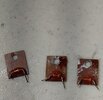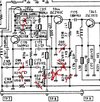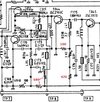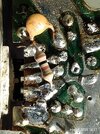I got this old Galaxy Saturn radio to bring back to life.
Working on the RF output. It had several watts of carrier for AM,
and SSB was "rough" "scratchy" sounding bad I was told.
did the usual RF output transistor bias level check at first.
at driver transistor TR44 the bias would barely change, and it was
around 1.8 Amps! so a problem here! It was due to the thermally mounted
MV1Y diode being open and not conducting, so all current through
the transistor base from this bias circuit failure.
at the two finals the bias would not adjust also. it was high.
found one of the thermally mounted MV1Y diodes to conduct
at .4 V, and the other at .8 V and also a 1 ohm "fuse resistor"
in a base bias line blown open. and while doing these tests, then the key-up
8.4 V transistor TR38 and diode D77 blew out.
so there problem in this bias circuit, on this radio, so with 8.4 V regulated
going to this circuit, a reliable bias circuit should be possible.
and looking things over, it was easy. it can be applied to these
other bipolar transistor RF ouput radios from RCI/Galaxy.
took out some parts, and got the 8.4 V key-up working again.
then put the following bias circuit in. got it biased correctly.
getting 10 Watts carrier with full modulation, and over-modulation
if wanted, and about 40 Watts PEP out in SSB.
..

cut out and remove these MV1Y diodes. trash them!
they did no good. made things worse!
Then put the screws back in transistors to heat sink rear panel.
..

- remove these parts. You can cut most of them out.
..

- Make this circuit. put these quarter-Watt 680 (2), 470, and 100 Ohm resistors
in place. the "fuse resistors" R218. R216, R271 can be removed and by-passed also.
..

the 100 ohm resistor soldered to the bypass capacitor
that they forgot. it is not on the schematic. they added
it later. foil-side at circuit to the 2SC2166 driver transistor.
Working on the RF output. It had several watts of carrier for AM,
and SSB was "rough" "scratchy" sounding bad I was told.
did the usual RF output transistor bias level check at first.
at driver transistor TR44 the bias would barely change, and it was
around 1.8 Amps! so a problem here! It was due to the thermally mounted
MV1Y diode being open and not conducting, so all current through
the transistor base from this bias circuit failure.
at the two finals the bias would not adjust also. it was high.
found one of the thermally mounted MV1Y diodes to conduct
at .4 V, and the other at .8 V and also a 1 ohm "fuse resistor"
in a base bias line blown open. and while doing these tests, then the key-up
8.4 V transistor TR38 and diode D77 blew out.
so there problem in this bias circuit, on this radio, so with 8.4 V regulated
going to this circuit, a reliable bias circuit should be possible.
and looking things over, it was easy. it can be applied to these
other bipolar transistor RF ouput radios from RCI/Galaxy.
took out some parts, and got the 8.4 V key-up working again.
then put the following bias circuit in. got it biased correctly.
getting 10 Watts carrier with full modulation, and over-modulation
if wanted, and about 40 Watts PEP out in SSB.
..

cut out and remove these MV1Y diodes. trash them!
they did no good. made things worse!
Then put the screws back in transistors to heat sink rear panel.
..

- remove these parts. You can cut most of them out.
..

- Make this circuit. put these quarter-Watt 680 (2), 470, and 100 Ohm resistors
in place. the "fuse resistors" R218. R216, R271 can be removed and by-passed also.
..

the 100 ohm resistor soldered to the bypass capacitor
that they forgot. it is not on the schematic. they added
it later. foil-side at circuit to the 2SC2166 driver transistor.
